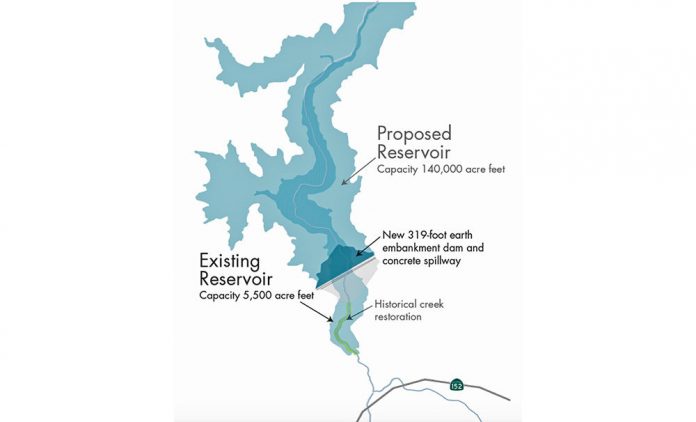The Santa Clara Valley Water District is moving forward with plans to build a new Pacheco Pass reservoir in Santa Clara County, which the district describes as a “game-changer” to ease the impact of future droughts in the Bay Area.
If $485 million in state funds are approved this month, supporters they could raise the rest of the $969 million project budget from federal grants and increased water rates to build the largest reservoir constructed in the Bay Area in the past 20 years.
The water district board on June 26 approved a memorandum of understanding between the Santa Clara Valley Water District, Pacheco Pass Water District and San Benito County Water District and approved an option to buy land with the Pacheco Pass Water District for the massive dam and reservoir project, which has been in the planning stages for a decade.
The board last year submitted an application to the California Water Commission for funding of the project under Proposition 1, and final hearings before the commission were held in late June. The commission’s decision on state funding is expected by the end of July.
While the Prop. 1 application is being evaluated by the water commission, the water district said it may seek federal legislative authorization for construction funding from Federal Water Infrastructure Improvements.
“The Pacheco Reservoir Expansion Project is a modern solution to the age-old challenges of providing a sustainable water supply for our expanding population and businesses,” district staff said in a report. “This project will reduce the frequency and severity of water shortages, provide flood protection for disadvantaged communities, as well as protect and grow the native steelhead population.”
The proposed state funding would come from Prop. 1, which was approved by nearly three-quarters of San Benito and Santa Clara county voters in 2014. The funding would come from the $2.7 billion Water Storage Investment Program, part of California’s Water Quality, Supply and Infrastructure Improvement Act of 2014, a $7.5 billion bond passed by voters.
The project would establish a new dam and expanded reservoir on the North Fork of Pacheco Creek that could hold 141,000 acre-feet of water, a substantial increase from the 6,000-acre-foot capacity of the existing reservoir. Constructed in 1939 and used for groundwater recharge, the reservoir is located about 13 miles southwest of San Luis Reservoir, off Highway 152.
The district describes project’s potential benefits as “vast,” including the following:
-
Increase suitable habitat in Pacheco Creek for the federally threatened South Central California Coast steelhead
-
Develop water supplies for the environmental needs of wildlife refuges to support habitat management in the delta watershed
-
Reduce flood risks for communities along Pacheco Creek and the Pajaro River as it flows through Watsonville
-
Improve water quality, reducing taste and odor problems that result from seasonal algae blooms in San Luis Reservoir and cause Santa Clara Valley Water District operators to curtail deliveries from this source
-
Provide an emergency water supply to Santa Clara and San Benito counties
-
Increase reliability of imported water supplies to Santa Clara and San Benito counties
-
Provide additional water for groundwater recharge, benefiting agricultural water users downstream of the new dam
-
Increase operational flexibility of water supplies at San Luis Reservoir and throughout Santa Clara County
-
Improve opportunities for water transfers through San Luis Reservoir
District board member Gary Kremen, who chairs the water district’s Pacheco Reservoir Exploratory Ad Hoc Committee, said, “It is not often that we encounter an opportunity to build something that will have such profound benefits for the environment, flood control and water supply. There are few suitable spots in California for new water storage, and fewer still that substantially help threatened fish species. We’re fortunate to have one of those spots in our backyard.”
The expanded reservoir would be filled with storm runoff from the surrounding watershed, and would also be used to store water imported through the Sacramento-San Joaquin Delta.
The project would include a new earthen dam and spillway. Other features are new pipelines, tunnels and a pump station to connect the new reservoir to the Pacheco Conduit, an existing pipeline near Highway 152 that conveys water from San Luis Reservoir to Santa Clara and San Benito counties.
Key project partners include the Pacheco Pass and San Benito County water districts and eight wildlife refuges in the San Joaquin River Hydrologic Region. Support letters from 46 California state legislators, organizations, resource conservation districts, water agencies and individuals were included in the application.
Jerry J. Smith, Ph.D., a fisheries biologist with experience studying Pacheco Creek since 1972 wrote the district, “The additional storage in the enlarged reservoir would potentially allow for increased releases from the reservoir into Pacheco Creek for rearing, including expanding releases to drought years when the existing reservoir would have insufficient storage to provide adequate releases for rearing steelhead.”
Josué García, CEO of the Santa Clara and San Benito Counties Building and Construction Trades Council, wrote, “This investment in our future will create both short- and long-term jobs as well as increase local control of the water supply. Together, these changes will create consistent economic growth for the entire Silicon Valley.”
The land is currently owned by the Pacheco Pass Water District, which manages the Pacheco Reservoir.
The Santa Clara Valley Water District agreed to pay the Pacheco Pass Water District $200,000 for the land under a 15-year option. The Santa Clara district would then construct the new $969 million reservoir near the existing reservoir north of Highway 152.
The Santa Clara Valley Water District is a government agency based in San Jose that provides water and flood protection to 1.9 million people from Palo Alto to Gilroy.
The existing reservoir was built on the North Fork of Pacheco Creek in 1939 behind a 100-foot earthen dam now badly in need of costly repairs.
The water district has yet to identify where the other $484 million needed to build the new reservoir would come from.
For more information, visit https://www.valleywater.org/project-updates/dam-reservoir-projects/pacheco-reservoir-expansion-project-proposed.








